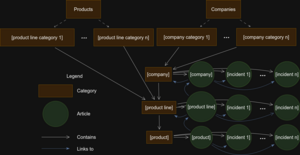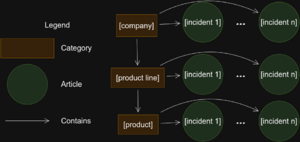Consumer Action Taskforce:Categorization

This article describes how categories are chosen for different types of pages. This is useful for users who want to help maintain the wiki by clearing out uncategorized pages (list), uncategorized categories (list) and wanted categories (list).
Users who frequently create new pages also need this information.

Incidents
An incident can apply to a specific product, a whole product line or a company (and/or all of its products) in general.
An incident that applies to a specific product should belong to that product's category. For example, the Pixel 4a Battery Performance Program article should belong to [[Category:Pixel 4a]].
An incident that applies to a whole product line should belong to that product line's category.
An incident that applies to all of a company's products, or that should be known to anyone considering buying one of their products, should belong to the company's category.
Incidents should also be categorized according to the categories in Category:Incidents. These categories are a work in progress, and this section will be updated once a system has been established.
Companies
Company articles
Company articles belong to their respective category. For example, the Sony article belongs to [[Category:Sony]].
Company categories
Rules
Company categories are categorized by industry. To avoid confusion, they are categorized based on how the corresponding article is categorized on Wikipedia.
When transferring the categories from the corresponding Wikipedia article, the following apply:
- Categories must describe the company in a way that relates to the products and services it provides.
- Categories do not contain information about the year or country of establishment. These are not important for the purposes of this wiki.
- Categories that belong to the "Companies by industry" category on Wikipedia belong to the Companies category on this wiki.
Example
As an example, consider the Wikipedia page for Sony, one of the companies with the most categories on Wikipedia:
The following categories do not describe Sony in a way that relates to its products and services:
- TOPIX 100
- 1950s initial public offerings
- Belgian Royal Warrant holders
- Companies in the Nikkei 225
- Companies listed on the New York Stock Exchange
- Companies listed on the Tokyo Stick Exchange
- Conglomerate companies based in Tokyo
- Mitsui
Examples of categories on other pages that do not relate to the company's products and services include:
- Privately held companies
- Family-owned companies
- Multinational companies
Here are a few categories with years or countries of establishment removed:
- Computer companies of Japan →
[[Category:Computer companies]] - Electronics companies established in 1946 →
[[Category:Electronics companies]]
Click "[Expand]" on the right to view the final list of categories at the bottom of the Category:Sony page.
[[Category:Computer companies]] [[Category:Computer hardware companies]] [[Category:Computer storage companies]] [[Category:Computer systems companies]] [[Category:Display technology companies]] [[Category:Electronics companies]] [[Category:Headphones manufacturers]] [[Category:Lens manufacturers]] [[Category:Loudspeaker manufacturers]] [[Category:Microphone manufacturers]] [[Category:Netbook manufacturers]] [[Category:Photography equipment manufacturers]] [[Category:Portable audio player manufacturers]] [[Category:Radio manufacturers]] [[Category:Software companies]] [[Category:Video equipment manufacturers]]
Products, services, websites and software
Articles can be about products, services, websites and software, or a combination of these. The distinction between some of these terms is vague, so this wiki chooses to take liberties from Wikipedia's system.
Product line articles
Product line articles belong to their respective category. For example, the Google Pixel article belongs to [[Category:Google Pixel]].
Product line categories
Rules
A product line's category page should belong to the manufacturer's category page. For example, Category:Google Pixel should belong to Category:Google.
Product line categories are also categorized by type. To avoid confusion, they are categorized based on the categories on Wikipedia.
When transferring the categories from Wikipedia, the following apply:
- Categories must describe the type of product.
- Categories do not contain extra information unrelated to the product type. This extra information should be omitted.
- Categories that belong to the "Products by type" category on Wikipedia belong to the Products category on this wiki.
- Categories are sourced from the following pages on Wikipedia if they exist:
- Any product's article.
- That product's corresponding category.
- The product line's article.
- That product line's corresponding category.
Example
As an example, consider the Google Pixel product line. Categories can be sourced from the following articles on Wikipedia:
- Pixel 4a
- Category:Pixel 4a (does not exist; skip)
- Google Pixel
- Category:Google Pixel
The categories on Wikipedia follow. These categories should be modified according to the rules outlined above.
The following categories do not describe a type of product:
- Google hardware
- Computer-related introductions in 2013
Here are a few categories with extra information removed:
- Discontinued smartphones →
[[Category:Smartphones]] - Mobile phones introduced in 2020 →
[[Category:Mobile phones]]
Click "[Expand]" on the right to view the final list of categories at the bottom of the Category:Google Pixel page.
[[Category:Google]] [[Category:Android (operating system) devices]] [[Category:Mobile phones]] [[Category:Smartphones]] [[Category:Tablet computers]]
Product articles
Product articles belong to their respective category. For example, the Pixel 4a article belongs to [[Category:Pixel 4a]].
Product categories
A product's category page should belong to the product line's category page. For example, Category:Pixel 4a belongs to [[Category:Google Pixel]].
Products that do not belong to a line of products
Note that there are products that do not belong to a line of products. Google Glass is one such product. These products should be categorized as if they themselves are product lines, i.e. they should follow the rules in #Product line articles and #Product line categories above.
Rationale
Introduction
This section explains the rationale for the current design of the company and product category hierarchy. It approaches the problem of a reader trying to find all incidents associated with a product they're considering purchasing.
In order to learn about the consumer protection flaws of a product, the reader will search for the product on this wiki to see if there are any flaws related to that product specifically. This will land the user at the product's article.
Duplication of information
There is some information that cannot be represented on the product's article because it affects multiple products. Information that affects multiple products cannot be repeated across those product pages because this information duplication would greatly increase the work associated with improving and amending the information.
In order to avoid repeating the information, it can be extracted into a separate article that covers all affected products. This article must be linked to from the product article, as shown by the blue arrow in the diagram nearby.
As an example, consider information about an issue affecting all Pixel devices. This information can't be repeated across all Pixel product pages for the reasons mentioned above. It needs to be extracted into a separate article. This is a product line article. The product article must link to the product line article so that the user can easily navigate to it.
Some issues apply to all of Google's products, not just its Pixel devices. This information can't be repeated across all the product line articles, so it needs to be extracted into a separate article. This is a company article. The product line article must link to the company article.
The importance of product line articles
In order to reduce the amount of articles, a contributor may consider moving the product line information to the company article. However, when the user, considering buying the product, looks at the company article, they have to wade through information about product lines that they are not interested in. Thus, product line articles are critical for ensuring that readers only read about incidents that affect the products they are considering buying.
Conclusion
To recap the user's process: The wiki contains a product article, a product line article and a company article. The user lands on the product article page because they searched for it. This article does not contain all incidents affecting the product, so they navigate to the product line article. After that, they navigate to the company article. None of these articles contain incidents that do not affect their product.